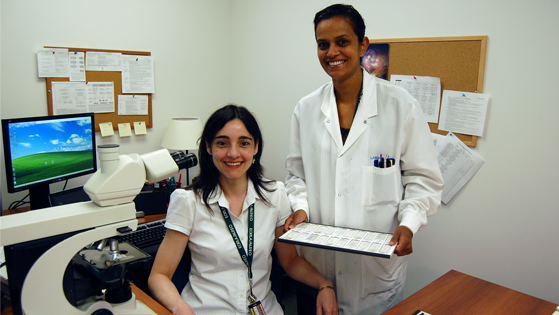
Lab Technologist Marilyn Harnarine (right) delivers a tray of slides to Dr. Paula Blanco, Pathologist. Patients are getting diagnoses much faster now that pathology turnaround times have been cut in half.
“Do I have cancer or not?” Waiting to hear the news is incredibly stressful, but patients are getting faster diagnoses thanks to improved Pathology Laboratory turnaround times – they’ve been cut in half since March.
Dr. Diponkar Banerjee, Division Head of Anatomical Pathology, and William Parks, Manager of Pathology, made changes that have reduced the turnaround time for lab specimens from an average of nine days to 4.5 days. The improvement helps all patients, but particularly cancer patients, who represent 60 to 70 percent of cases handled.
“They’ll get the diagnoses faster and caregivers can make their treatment plans faster,” said Dr. Banerjee, adding that even if it’s bad news, it’s better to know sooner. “The anxiety of waiting is very significant.”
Parks said the lab receives 300 to 400 specimens per day and produces 2,000 to 2,500 slides per day, putting TOH among the busiest hospitals in Canada.
“We’ve really streamlined the process,” said Parks, who described his work as being like an orchestra conductor. “An orchestra of highly trained musicians can sound like hell if they’re not being directed properly. We got out of synch but now we’re pulling it back together.”
The many changes made since March include:
- Regulating the workflow. Slide production is more evenly paced and pathologists receive several small batches of slides throughout the day for analysis, rather than one large batch at the end of the day. Clinics sending specimens, such as TOH Breast Health Centre, support the change.
- Making the workload consistent among pathologists, with a cap of 200 slides per day.
- Adding regular evening and Saturday shifts for technologists.
Parks said it’s hard to pinpoint the cost savings, but staff numbers are the same, overtime has been reduced and the health-care system as a whole saves when turnaround times are shorter.
Other results include a backlog that’s significantly reduced, fewer rush cases that disrupt work flow, higher staff morale, lower staff stress, and more time for staff to spend teaching residents and doing academic work (the publication rate is improving).
“Everyone’s very happy,” said Dr. John Veinot, Head of the Pathology and Laboratory Medicine Department. “It always boosts our morale when we provide better patient care. We have a great team.”

Support patient care and research at
The Ottawa Hospital


 To reset, hold the Ctrl key, then press 0.
To reset, hold the Ctrl key, then press 0.